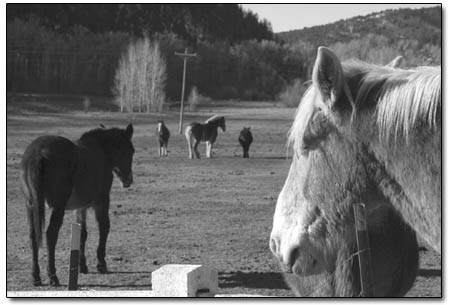 |
Areas like this pasture,
along County Road 234, could be targeted as potential open
space under a transferable development rights program being
considered by the county and the city. Under such a plan,
rights to areas earmarked for open space could be bought
from willing landowners and transferred to areas designated
for higher-density development.
/Photo by Todd Newcomer. |
In the midst of the recent swell of development,
La Plata County is searching for an antidote to sprawl. For
the last four months, a working group has been studying an open
space tool known as transferable development rights (TDRs).
Currently, the biggest obstacle to development of a pilot TDR
program is cooperation and consensus between county and city
governments.
On Oct. 20, La Plata County commissioners unanimously voted
to enter a six-month moratorium on development in the Grandview
area. The moratorium was enacted, in part, to give county staffers
a breather and a chance to investigate TDRs.
In brief, TDRs are the process by which property rights are
purchased in “sending areas,” places earmarked as
vital open space. Developers then take these rights to urban,
“receiving areas” where they have the opportunity
to develop density in excess of regulations.
The Grandview area, where the Southern Ute Indian Tribe has
proposed 2,500 new units centered around an expanded Mercy Medical
Center, has been deemed an appropriate receiving area. The potential
high density of the development and the prospect for bringing
the area within Durango city limits make it a good candidate
for TDRs.
At the time the moratorium was adopted, Joe Crain, director
of county planning, commented, “There’s a real opportunity,
I think, to make the Grandview area a dense urban area and give
developers an incentive to purchase and transfer development
rights.”
Since that time, a group known as the Grandview Rural Urban
Incentive Demonstration Group (GRID) has worked to determine
whether Grandview does in fact represent a real opportunity.
According to Crain, one the largest obstacles to a TDR program
has been making sure the receiving area, the City of Durango,
also would benefit.
“If we’re going to have a workable program, we’re
going to have to find something that’s agreeable to both
the county and city,” he said. “I think our task
is to narrow this thing down to where it’s beneficial
to the city.”
Tom Maynard, a consultant with the Four Corners Planning and
Design Group who has been hired by GRID to guide the process,
agreed that the city must get more than additional growth out
of the program.
“The main challenge is to make sure the city of Durango
buys into the program,” Maynard said. “Some of the
city councilors have been reluctant so far.”
Maynard said this reluctance is partly because preserving open
space in La Plata County would be accomplished by driving up
Durango’s size and population. “While it’s
possible to have a wide, geographic sending area like La Plata
County, it’s important that the city sees some immediate
benefit,” he said.
City Planner Greg Hoch said that from his perspective, the
TDR issue is still too murky. “I don’t think we’ve
reached the stage where everyone understands what’s involved,”
he said. “The fact that the city may appear reluctant
isn’t so much that we have problems as we need more information
and comprehension of what’s at play.”
Hoch did add, however, that any TDR program would have to be
mutually beneficial to both city and county. He said more dialogue
would be necessary. “Where we’re at with the GRID
group and with the city is determining how this process might
work to simultaneously benefit the city and the county,”
Hoch said. “We’re not there yet.”
One hurdle that the group has surmounted is a determination
of what kinds of land a TDR program would target for preservation.
Maynard remarked that five categories of land types have been
selected – corridors adjacent to highways, river corridors,
agricultural parcels, greenbelts around developed areas and
critical wildlife habitat. He noted that the highway corridors
and greenbelts would be directly beneficial to Durango. Maynard
is currently mapping the entire county to show which areas contain
one or more of these characteristics. Tracts with the most attributes
would receive the highest priority.
“There are some parcels that will have all five of those
attributes,” said Maynard. “Those offering more
public benefit might be granted more value.”
The GRID group has another meeting scheduled for Feb. 19, where
it will continue to debate subjects like the merits of unit-based
TDRs vs. value-based TDRs. Until these kinds of questions are
resolved, the realities of implementing a TDR system in La Plata
County will remain a large unknown.
“It certainly hasn’t been decided,” said
Maynard. “It seems like a good number of the working group
has bought into TDRs. I don’t know whether a program will
actually be on the ground by April 20, but we’ll probably
have a decision on whether we’re going forward or not.”
Crain agreed that the group is generally in favor of TDRs.
“We’re making some headway,” he said. “It’s
kind of too early to tell, but I think there is some buy-in
by everybody.”
However, the GRID group also is rapidly approaching a hard
deadline. The county’s moratorium on Grandview development
expires April 20, and the details may prove too numerous to
resolve by that time. Crain concluded by saying that an extension
of the moratorium to serve county and city needs may be necessary
at that time.

